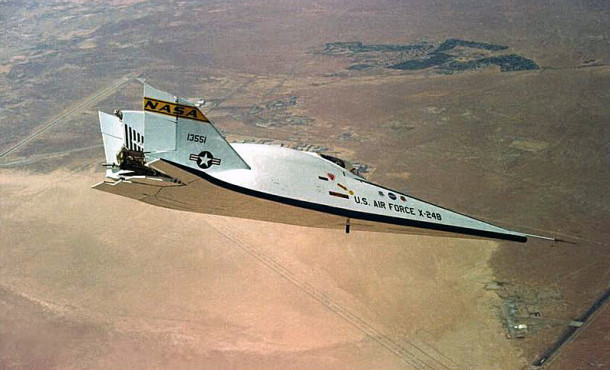
Forty-two years ago this week, the USAF/NASA/Martin X-24B became the first lifting body to make an unpowered precision landing on a concrete runway. The feat was pivotal to convincing NASA officials that landing the Space Shuttle Orbiter in an unpowered state was operationally feasible.
Early Space Shuttle Orbiter operational concepts featured the use of a pair of turbojets to provide a powered landing capability. These airbreathing engeines were to be internally stowed just below the Orbital Maneuvering System (OMS) pods. The turbojets would be deployed and started once the Orbiter had decelerated to high subsonic flight speeds.
While airbreathing propulsion would give the Orbiter a loiter and go-around capability, the drawbacks were significant. Jet fuel would have to be carried into and out of earth orbit. The weight of this fuel and the turbojets would severely penalize Orbiter payload capability. Further, the system would increase both the complexity of and cost to Shuttle operations.
As the Shuttle Program grappled with the development of a powered landing capability for the Orbiter, the NASA DFRC flight test community made what appeared to be a rather bold claim. The Orbiter could simply glide all the way to touchdown and land deadstick. After all, X-planes had been doing so safely and without incident since the late 1940’s.
A leading proponent of unpowered Shuttle landings was NASA DFRC test pilot John Manke. He was convinced that the Orbiter could routinely and safely conduct unpowered precision landings on a concrete runway. If true, the Orbiter could land anywhere a 15,000-foot concrete runway was located.
Manke proposed that the X-24B (S/N 66-13551) lifting body be employed to conduct unpowered precision landings on Runway 04/22 at Edwards Air Force Base. He and fellow test pilot USAF Lt. Col. Michael V. Love practiced low lift-to-drag precision landings using F-104 and T-38 aircraft in preparation for the demonstrations.
On Tuesday, 05 August 1975, John Manke successfully made the first-ever unpowered precision landing of an aircraft on a concrete runway. The X-24B main gear touched-down exactly at the aimpoint situated 5,000 feet down Runway 04/22. On Wednesday, 20 August 1975, Mike Love duplicated the feat.
Following the successful unpowered precision landings with the X-24B lifting body, John Manke was quoted as saying: “We now know that concrete runway landings are operationally feasible and that touchdown accuracies of ±500 feet can be expected.” NASA Space Shuttle Program management concurred and officially adopted the unpowered precision landing concept.
History records that thirty-one years of Orbiter flight operations confirmed the wisdom of that long-ago decision.

